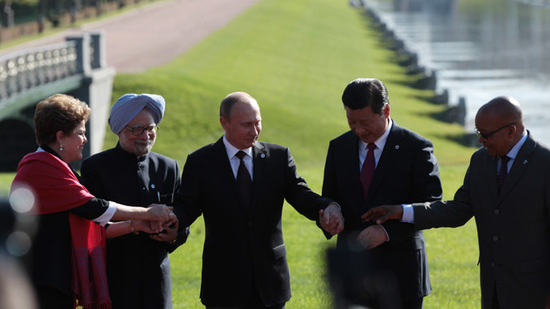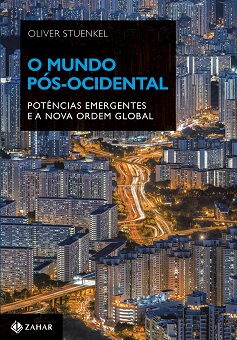As was expected, BRICS leaders have agreed on the creation of a $100 billion pool of currency reserves, taking an important step in the institutionalization process of the grouping. Russia, India and Brazil will each add $18 billion to the pool, while South Africa will provide $5 billion. China, by far the largest BRICS economy, will contribute $41 billion. They also agreed to seed a new development bank with $50 billion of capital. Countering critics of the group, the decision can be expected to consolidate intra-BRICS cooperation, enhance trust and strengthen the bloc’s capacity to absorb external financial impacts. At the same time, it can in no way be seen as an alternative to the IMF, which has resources eight times larger than the BRICS fund.
The set-up of a reserve pool was easier because it needs no physical structure to function. Each country’s central bank will keep the fund’s reserves as part of its own reserves. Only in moments of crisis in one of the member countries’ economies will the contingency fund begin to operate, acting as a cushion or back-up. Worries about an unequal distribution of power within the arrangement are unnecessary because unlike in the proposed BRICS Development Bank, where voting rights are established on the basis of the financial contribution of each country, the vote of China, Brazil, India or Russia will be enough to authorize the disbursement of funds, making South Africa the only actor that does not exert full control over the fund.
For several observers, the creation of a $100 billion contingency relief arrangement is a bid to sow the seeds of an alternate financial structure for developing countries, arguing that it could present a direct challenge to the IMF. After the 5th Summit, the Indian media hailed the creation of the CRA as “a major win for India’s campaign to reform global financial architecture.”
Yet such an interpretation is largely unfounded – for now. This is mainly so because $100bn fund is relatively small by global standards. The BRICS countries control almost $5tn in international reserves, and if they were to contribute 16% of their reserves to a contingency fund the resulting CRA would total $800bn against $780bn in resources at the IMF. Of course, a CRA of 100 bn could be the stepping stone of something far larger, which could then truly undermine today’s global financial order.
At the same time, arrangements similar to the BRICS CRA already exist and have not undermined the IMF. The BRICS’ CRA is closely modeled on the Chiang Mai Initiative signed in May 2000 between the Association of Southeastern Asian Nations (ASEAN) countries as well as China, Japan and South Korea. The aim of the initiative is to strengthen the region’s capacity to protect itself against risks in the global economy. It is intended to provide a supply of emergency liquidity to member countries facing currency crises—and avoid the need to depend on the IMF, which is seen, until today, as having abused its power in its emergency loans during the Asian financial crisis of 1997–98. The crisis is often referred to in the region as “the IMF crisis.” After establishing headquarters in Singapore in 2009, the CMI was renamed the Chiang Mai Initiative Multilateralization (CMIM).
However, ultimate proof that the CMIM is not a threat to the IMF is the rule that a country under the CMIM umbrella could only access a small proportion of its line of emergency credit without being forced to enter into negotiations with the IMF for a standby agreement. Only 30% of a member’s quota is accessible without an IMF program. For the remaining 70% the member state must agree to an IMF program, including the much-loathed policy prescriptions.
In this sense the Chiang Mai Initiative Multilateralization is far from a counterweight to current IMF-led order. Unless the BRICS’ CRA explicitly eliminates such an arrangement with the IMF, it too will be nested within the current system.
Funds have never been disbursed under the CMIM framework – when South Korea needed emergency liquidity in late 2008, it went directly to the U.S. central bank, so avoiding the humiliation of yet again having to deal with the IMF. In the same way, Indonesia preferred not to deal with CMIM (i.e. IMF) and requested help from Japan.
The BRICS’ CRA is in many ways more courageous than the CMIM because it creates a global network, making it potentially far more powerful: A regional crisis in Brazil, for example, could be easily dealt with by the other BRICS, which may not be affected at all, thus reducing the risk that the crisis could globalize.
The key question, as with most other attempts to institutionalize South-South cooperation, is in how far the BRICS can establish clear norms and rules – for example, about whether CRA disbursements will be tied to policy conditionalities. If so, what will they look like? According to which paradigms will they be developed, if not following an IMF-inspired logic? Can the BRICS establish criteria according to which disbursements will be provided without replicating the much-criticized IMF?
Read also:
Is Brazil ready to play hardball?
The end of the emerging world?
Book review: “Liberty’s Surest Guardian” by Jeremi Suri
Photo credit: Igor Russak/RIA Novosti









